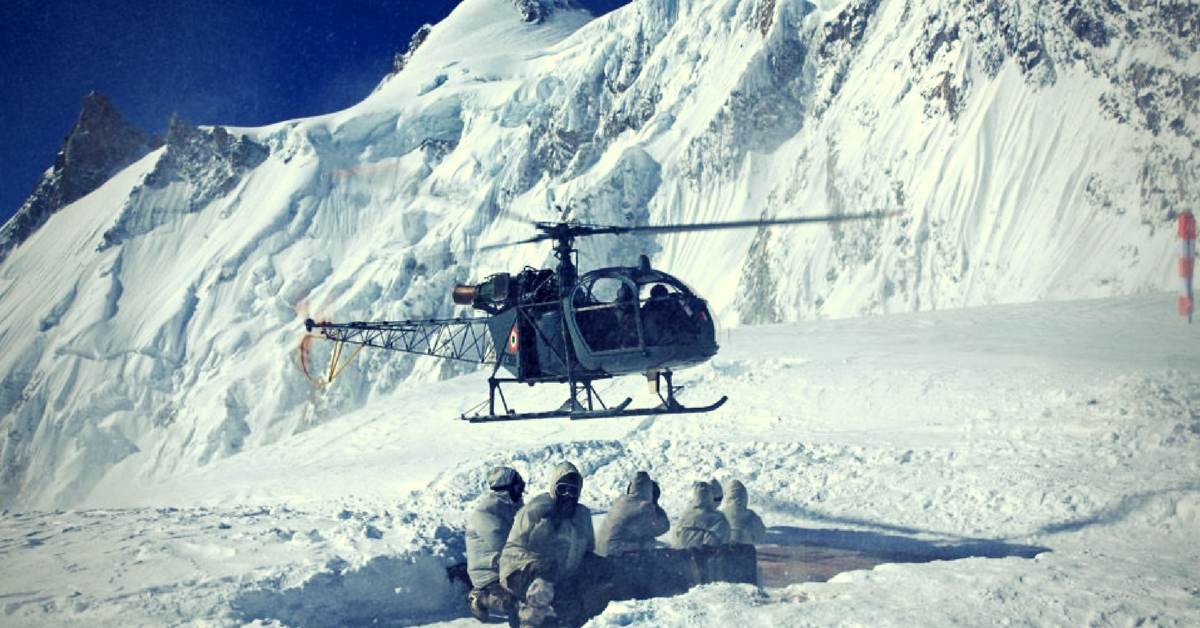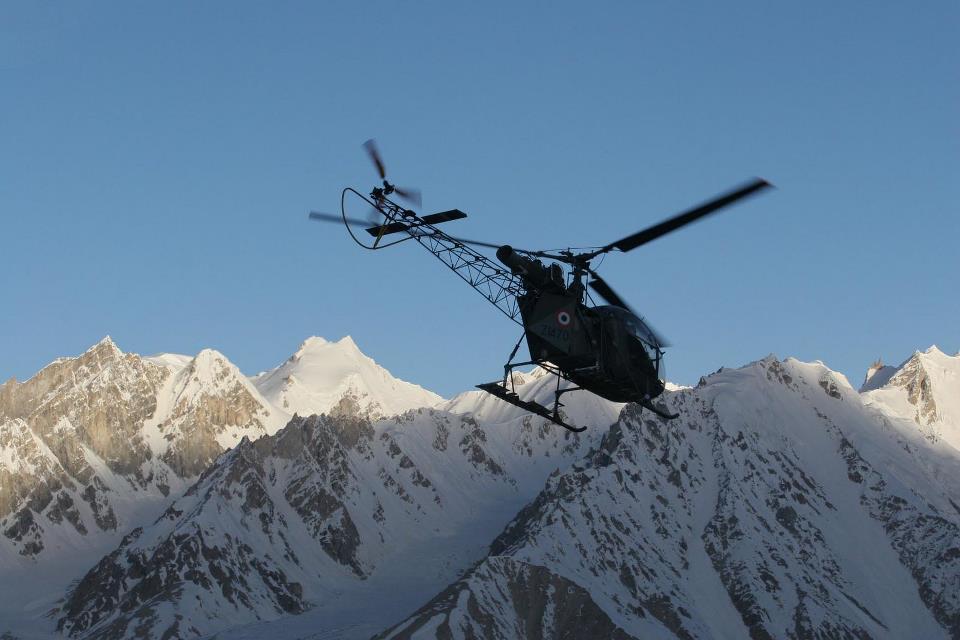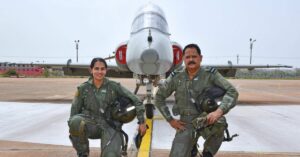What Did The Army Do For India’s First Pilot to Land On Siachen? Here’s The Incredible Story
It was a mission he should have never undertaken, but the call of duty was too strong.

In a remarkable tale of brotherhood, courage, daring and “stupidity” atop the Siachen Glacier (one of the most inhospitable battleground terrains in the world), veteran helicopter pilot Air Vice-Marshal (AVM) Manmohan Bahadur (Retired) of the Indian Air Force presents a compelling account about the deep bond that exists between pilots in the air and soldiers on the ground.
At an altitude ranging from 12,000-24,000 feet above sea level, and temperatures dipping to -50 degrees Celsius, one can ascertain that the only reason why the armed forces have soldiers posted at Siachen Glacier is that of the critical strategic value it holds for India vis-à-vis Pakistan.
Writing in The Print, AVM Bahadur describes in wonderful detail one mission he undertook as Commanding Officer of the 114 Helicopter Unit, also known as Siachen Pioneers, in the mid-1990s. It’s imperative to note that he was among the first pilots to land on Siachen in 1978.
Also Read: Col. Narendra ‘Bull’ Kumar, the Unsung Legend Who Secured Siachen For India
To the uninitiated, the Siachen Pioneers are part of a helicopter unit of the Indian Air Force equipped with the Cheetah Helicopter, a high performance helicopter designed for operation over a very wide range of weight, centre of gravity and altitude conditions. The unit is based out of Leh.
The Siachen Pioneers play a critical role in assisting the Indian Army personnel posted along various camps on the Siachen Glacier, delivering critical supplies, conducting rescue operations and transporting soldiers in need of emergency medical treatment. They are literally the lifeline of those soldiers tasked with defending the nation’s borders in godforsaken conditions.

One day, AVM Bahadur was conducting a set of training sorties for newly posted pilots. They were being taught to land their helicopters on a ‘track’ marked out by army personnel on the pristine white snow with wooden sticks to avoid the deathly deep crevasses spread across the glacier.
“When the sun was out and visibility good, the pilots had no problem of being orientated—but with a low cloud cover, drifting fog and low visibility, the ‘track’ was the only way to fly safely as it helped the pilots to orientate in space and, if there was an emergency and the helicopter had to be put down, one’s life could be saved if the force-landing was close to, or on, the ‘track’—the rescue party would come only on it to avoid the crevasses on either side,” writes AVM Bahadur.
After returning from this exercise to the Base Camp, he received a call from an army commander at one of the bases seeking urgent assistance for a soldier in dire need of medical treatment. After making all the necessary arrangements, two helicopters set off for the rescue mission with the CO flying in one of them. At the camp, they hurriedly transported a Naga soldier suffering from high-altitude cerebral oedema, a condition where the brain swells with fluid due to high altitude.
Despite getting the young Naga soldier back to base camp in quick time, the medics were unable to save him, a piece of information that would come later. This is a difficult reality of operating in these conditions. Barely any soldiers die in combat in these parts. Most of them suffer from dehydration, high-altitude pulmonary oedema (water in the lungs) due to the cold and high-altitude cerebral oedema, among other conditions.
Also Read: Here Are 10 Facts You MUST Know about Surviving Siachen
After the rescue mission, AVM Bahadur was ready to leave for Leh when at that moment, a Colonel leading a battalion that was newly posted at Siachen, sought urgent assistance for 20 personnel posted at Amar Camp, situated at 19,900 feet above sea level. The soldiers at Amar Camp were in desperate need of additional kerosene, without which survival is extremely difficult.
“The time was well past noon when winds pick up on the glacier, and only emergency casualty evacuation missions are permitted,” writes AVM Bahadur. While explaining the reasons why sorties aren’t allowed, the Colonel reportedly interjects with the news that an avalanche had taken away most of their kerosene-filled jerrycans and it was a question of survival.
As he was about to reject any such request, news came in that the Naga soldier couldn’t make it. “The face of that young Naga boy, in the prime of youth, and someone who would give Hindi film heroes a run for their money, came swimming in front of the eyes of the CO. No, he couldn’t be a party to losing a few more,” AVM Bahadur goes on to write.

Heading towards Amar Camp, however, visibility levels were beginning to drop, with the clouds lowering and the terrain rising. The ‘track’ that these pilots depend on was getting blurred amidst the snow, leaving the helicopter in a precarious situation.
“Everything suddenly turns white around him—the CO is wary of going down further as the helicopter could impact the pure white snow, whose closeness could not be discerned in the absence of any colour contrast to do that; but descend he must—to keep in visual contact with the ‘track.’ The glacier floor is rising ahead of him, and he has no option but to call off the mission,” AVM Bahadur writes.
However, as the helicopter turned back, it ran into a puff of clouds, leaving both the CO and his co-pilot in a precarious situation where none of them as any visual sense of what altitude they are flying in and wholly dependent on the flight instruments.
Also Read: Lion of Ladakh: The Legendary Soldier Who Saved India While Still a Teenager!
After some nervous moments, the tracks set up by the army personnel on the ground comes into view, and the pilots have rediscovered their orientation again.
“As he looks down he sees a file of soldiers trudging up on the track, bound to each other with a rope, and they wave at him; as he looks right, the hillside just whizzes past, the tough rocky protrusions from the snow clearly visible—he is that close,” writes AVM Bahadur.
Despite the folly of this mission determined by emotion over reason, what he attempts to describe is the unimaginable bond soldiers on the ground share with pilots in the air. Fear of losing other soldiers was the only reason this mission was undertaken.
“What saved the CO that day was the ‘track’ carved by the footsteps of the brave jawans who have been on the icy glacier for years guarding our inhospitable frontiers,” writes AVM Bahadur.
Fortunately, for the jawans at Amar Camp, they survived the night and the following morning sorties were made to deliver a week’s stock of kerosene.
Like this story? Or have something to share? Write to us: [email protected], or connect with us on Facebook and Twitter.
NEW: Click here to get positive news on WhatsApp!
If you found our stories insightful, informative, or even just enjoyable, we invite you to consider making a voluntary payment to support the work we do at The Better India. Your contribution helps us continue producing quality content that educates, inspires, and drives positive change.
Choose one of the payment options below for your contribution-
By paying for the stories you value, you directly contribute to sustaining our efforts focused on making a difference in the world. Together, let's ensure that impactful stories continue to be told and shared, enriching lives and communities alike.
Thank you for your support. Here are some frequently asked questions you might find helpful to know why you are contributing?


This story made me
-
97
-
121
-
89
-
167














